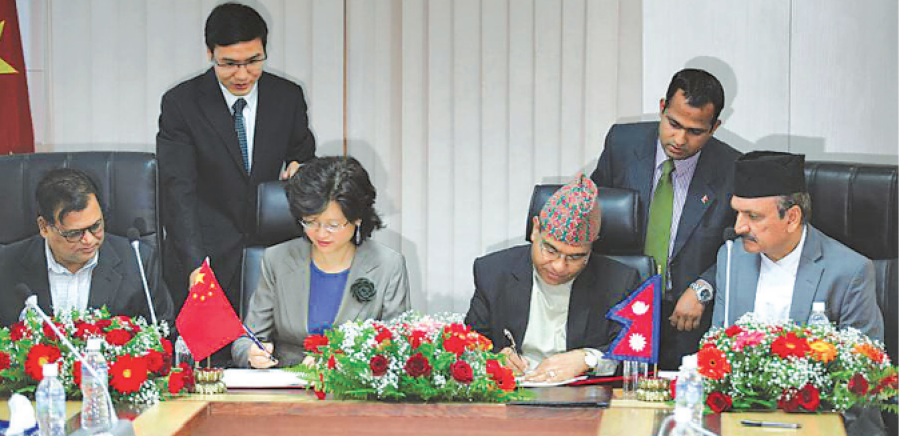National
‘BRI is good but Nepal should tread carefully’
Regional experts suggest the country should learn from others and better negotiate financial terms, saying priority should be on grants to fund projects.
Post Report
Former foreign ministers and experts have said that the China-led Belt and Road Initiative (BRI) is potentially good for Nepal but the country should be cautious while executing projects under it.
Nepal and China signed the framework agreement on the BRI in May 2017, but not a single project has been implemented so far with both sides still negotiating several features of the BRI including the project implementation agreement.
Speaking at a function organised by the Centre for Social Inclusion and Federalism in Kathmandu on Friday, Prakash Sharan Mahat, former foreign minister and the Nepali Congress spokesperson, said the BRI brings both opportunities and challenges for Nepal and implementation of BRI projects in Nepal should strictly be based on a cost-benefit analysis.
Talking about a free trade agreement, one of the key ingredients of the BRI framework, Mahat said it would put Nepal at a disadvantage and stressed the need for having further negotiations. Mahat was the foreign minister when Nepal signed the BRI agreement with China. Since Nepal could not accept commercial loans from any country, he suggested that the country negotiate for grants instead, for the BRI projects too.
Another former foreign minister, Pradeep Gyawali, who is also deputy general secretary of the CPN-UML, said Nepal should give the benefit of the doubt to the BRI.
Gyawali reiterated that Nepal should not take commercial loans to implement BRI infrastructure projects. “We don’t know whether we will fall into a ‘debt trap’ as we have not taken any loan from China for the projects selected under the BRI.”
Nepal has selected nine projects for the initiative.
Gyawali also said there is still room for negotiations with China to insist on grants or concessional loans as the neighbours have yet to decide on the financing modality for the projects.
The seminar also featured a series of presentations by four international delegates from South Asia, all of whom provided their country-specific experiences with the BRI.
Professor Srikanth Kondapalli, dean of the School of International Studies and Professor of Chinese Studies at Jawaharlal Nehru University, said that the BRI entailed China’s “strategic motive hidden under the guise of connectivity in South Asia and beyond”.
“While China claims to not interfere in the internal affairs of other countries, time and again, they have shown proclivity to do so as evident in parts of Africa,” added Kondapalli.
Harim Watson Peirish from the Council for Public Policy (CCP) in Sri Lanka argued that the BRI was not in the interest of the island nation. Peirish highlighted the case of Hambantota Port, which was leased out to China for 99 years in December 2017 after Colombo was unable to pay back Chinese loans.
Peirishthen added that the case of Hambantota Port and the ongoing economic crisis also reflected a failure of the political leadership. “First and foremost, it was extremely imprudent on Sri Lanka’s part to accept Chinese loans with such a high interest rate,” said Peirish.
Towfiqul Islam Khan from the Centre for Policy Dialogue in Bangladesh shed light on various challenges associated with China’s BRI, particularly the loan component with a higher interest rate, and a shorter payback period.
“Generally, Chinese ODA is a tied aid, and we [low-income countries] have fought long to untie it and should continue to do so,” said Khan.
Devendra Kumar from Sai Nath University in India; Akhilesh Upadhyay, senior fellow at the IIDS; Ajaya Bhadra Khanal, editor-in-chief at Ukaalo.com; Purushottam Ojha, former secretary of Minister of Industry, Commerce and Supplies; Rupak Sapkota, former deputy executive director at Institute of Foreign Affairs; and Shreeya Rana, senior program and research officer at PE, discussed various facets of the BRI.
They stressed that Nepal could benefit from better connectivity with its northern neighbour but to be able to do so, Nepal needed to negotiate better. They were of the view that Nepal could learn from the experiences of its neighbors in dealing with China.
As of August 2022, a total of 149 countries have signed MoUs on the Chinese connectivity project. In South Asia, five countries have already joined the initiative even though it has faced India’s opposition from the outset.




 7.12°C Kathmandu
7.12°C Kathmandu%20(1).jpg&w=200&height=120)














